
Essentials of Estate Planning
Table of Contents
Essentials of Estate Planning: A Guide for Everyone
Estate planning isn’t just for the super-rich; it’s about making sure your wishes are honored, your loved ones are cared for, and your assets are protected. Taking the time to plan now can save your family significant stress, time, and money in the future.
This guide will walk you through the essential aspects of estate planning, helping you understand how to manage your assets and personal wishes during your lifetime and after death.
Table of Contents
- 1. Inheritance Tax (IHT)
- 2. Discretionary / Disabled Beneficiary Trusts
- The Problem Without Planning
- What is a Trust?
- Components of a Trust:
- Types of Trusts for Disabled Beneficiaries:
- Setting Up a Discretionary Trust in a Will (A Will Trust):
- Crucial Tip: Always write a ‘Letter of Wishes’
- Key Characteristics of a Discretionary Trust:
- Important Note:
- Trustees of Discretionary Trusts:
- Funeral Arrangements:
- 3. Property Trusts
- How Local Authorities Assess Income & Capital for Care:
- Your Home:
- When Your Home is Ignored Completely:
- Local Authority Charges:
- General Guidance on Financial Assessment (Figures for England, may vary elsewhere):
- Can These Costs Be Avoided?
- Property Trusts in a Will (Tenants in Common):
- Benefits:
- Crucial Step:
- 4. Guardianship
- 5. Powers of Attorney (LPAs)
- 6. Advance Decisions (Living Wills)
1. Inheritance Tax (IHT)
It’s a common, and often sad, fact that many people, regardless of their wealth, are reluctant to seek estate planning advice. Through this oversight, they often enrich the government’s coffers rather than their own families or chosen beneficiaries.
By consulting an estate planner, individuals and their executors could potentially save their estates hundreds of thousands of pounds by substantially reducing or even eliminating Inheritance Tax (IHT) liability.
How Inheritance Tax Works
- In the UK, IHT is charged at 0% (Nil) on the first £325,000 of an individual’s estate – this is known as the Nil-Rate Band (NRB).
- Everything over this amount is currently taxed at 40%.
- This calculation includes not only UK property but also any foreign assets you own.
Important Note on Gifts & Trusts
- Since March 2006, if you put assets over your Nil-Rate Band into a trust, there is an immediate 20% tax payment due to HMRC on the amount above the NRB.
- However, if you give assets away as an absolute gift, there is no immediate charge – but be aware of the 7-year rule. If you die within seven years of making a substantial gift (not covered by an IHT exemption), its value will still be counted as part of your estate for tax purposes. A tiered reduction in tax applies after the third anniversary of the gift.
Key Exemptions
No tax is paid on assets transferred:
- Between married spouses or civil partners upon death.
- To registered charities.
- To UK established political parties.
Strategies to Reduce Your IHT Bill
There are several legitimate ways to avoid or limit IHT liability:
- Potentially Exempt Transfers (PETs): These are lifetime gifts of any amount. As long as the donor lives for seven years after making a PET, the asset is not considered part of the estate and is therefore exempt from IHT.
- Exempt Gifts: You can give away certain amounts each year without any IHT implications:
- Small Gift Exemption: Up to £250 to as many people as you wish each tax year.
- Annual Exemption: Up to £3,000 for a single gift each tax year (this excludes individuals who have already received a £250 small gift from you).
- Gifts in Consideration of Marriage/Civil Partnership: Specific amounts can be given to couples on their wedding or civil partnership day:
- Each parent can give up to £5,000.
- Each grandparent can give up to £2,500.
- Anyone else may give up to £1,000.
- Gifts to Charities or Political Parties: Gifts and bequests to registered charities or main political parties established in the UK are exempt from IHT.
- Gifts for National Heritage/Public Benefit: Gifts and bequests made to certain bodies concerned with the preservation of national heritage or of a public nature are exempt.
- Specific Property Exemptions: There are exemptions and reliefs for particular types of property, such as business property, agricultural land, woodlands, works of art, and historic houses.
Important: All gifts must be made as outright gifts. Both partners can make gifts, but be aware of any Capital Gains Tax that may be due on the transfer of certain assets.
Rules for Married Couples, Civil Partners, Widows, and Widowers
Significant changes introduced in 2007 greatly benefit married couples and civil partners. This brought in the concept of a transferable Nil-Rate Band (NRB) between spouses and civil partners, effectively allowing a couple to enjoy the benefits of two NRBs.
How it Works: The unused portion of the first partner’s NRB (calculated as a percentage) can be transferred to the surviving partner. This percentage is then applied to the NRB applicable at the time of the second death.
Example (Simplified, using a £300,000 NRB for illustration, though the actual NRB is £325,000):
- Mr. Smith dies, leaving £150,000 to his son and the balance of his estate to his wife. The Nil-Rate Band at the time of his death is £300,000, meaning Mr. Smith used 50% of his allowance.
- When Mrs. Smith dies later, the Nil-Rate Band is £350,000. She will benefit from an increased allowance of £525,000 (£350,000 plus 50% of £350,000).
Residential Nil-Rate Band (RNRB): In addition to the standard NRB, there’s also the RNRB. This allows an additional amount (currently £175,000 per person) to be passed on tax-free if you leave your main home (or its value) to your direct descendants (children, grandchildren, etc.). For a couple, this means an additional £350,000 could be protected.
- Combined with the standard NRB, this means a married couple or civil partners could potentially leave up to £1 million (£325,000 + £175,000) x 2 without paying IHT, if they leave their home to their direct descendants.
Maximising the Allowance: The maximum amount that can be claimed is 100% of the Nil-Rate Band allowance at the time of the second death. If someone has remarried multiple times, they can only claim one additional allowance.
Retrospective Benefit: This measure is backdated indefinitely for widows and widowers. This means those who have already lost their spouse or civil partner can take advantage of the increased allowance, regardless of when their first partner died.
Crucial Point: It is vital that appropriate planning is done while both partners are still living to take full advantage of these allowances.
Challenges for Unmarried Couples
Unfortunately, for unmarried couples, there is no spouse exemption from IHT on the first death. Any amount transferred that is over the current Nil-Rate Band (NRB) will be taxed at 40%.
Example:
- Andrew and Barbara have been living together for 15 years and have three children. They own a house together worth £500,000, held as tenants in common in equal shares (meaning each owns a distinct half). They also have other assets worth £40,000 (£20,000 each). A mortgage on the house would be paid off by an insurance policy on the first death.
- If they simply make standard Wills leaving everything to each other (and to the children if their partner pre-deceases), no inheritance tax would be payable on the first death as each partner’s estate (£250,000 house share + £20,000 other assets = £270,000) is worth less than the current NRB of £325,000.
- However, on the second death, the survivor’s estate would be worth £540,000 (the whole house + other assets). With a single NRB of £325,000, this would attract an IHT bill of £86,000 (40% of (£540,000 - £325,000 = £215,000)).
Options for Unmarried Couples:
- One way to save this tax is to leave their respective estates directly to the children on the first death; however, this could leave the survivor financially disadvantaged.
- Inheritance Tax Saving Wills (Loan Trusts): A more flexible solution involves “Inheritance Tax Saving Wills.” These Wills allow a legacy of up to the current Nil-Rate Band to be made to a discretionary trust in favour of the children. The trustees can then loan the trust assets back to the surviving partner, who can still have access to the trust fund, provided they promise to repay the loan from their estate upon their death. This can significantly reduce the IHT bill on the second death.
- Equalising Assets: For efficient IHT planning, it is essential that partners, as far as possible, equalize their assets (including real estate, savings, bank accounts, etc.). This includes holding real estate as Tenants in Common in equal shares, allowing half the value of the home to be included in the value of each partner’s estate.
2. Discretionary / Disabled Beneficiary Trusts
If you have a disabled child or loved one, ensuring their financial security without jeopardizing their eligibility for vital state benefits can be a complex and worrying concern. Trusts offer a powerful solution to provide for luxuries and extras that can enhance their quality of life.
The Problem Without Planning
- Poor planning, or no planning at all, can mean that payments from the Benefits Agency or Local Authority are stopped once an inheritance is received.
- A Receiver might be appointed by the Court of Protection to manage the affairs of the family member. This can result in delays, high fees, and the Receiver may not act as the family would wish.
- If a Will doesn’t make reasonable provision for a dependent who relies on Local Authority funding, a claim can be made against the estate, with costs coming directly from the estate.
What is a Trust?
A trust is a legal arrangement where assets – money, investments, real estate, or even valuable paintings – are managed by one or more persons (the Trustees) for the benefit of another (the Beneficiary). This management is governed by a set of Rules contained in a Trust Deed (or Will). The deed establishes the obligations of the trustees and how they are to use the trust property for the beneficiaries.
Components of a Trust:
- Beneficiaries: The individuals or entities who benefit from the trust.
- Assets: The property or money held within the trust.
- Rules: The instructions on how the trust assets are to be managed and distributed.


